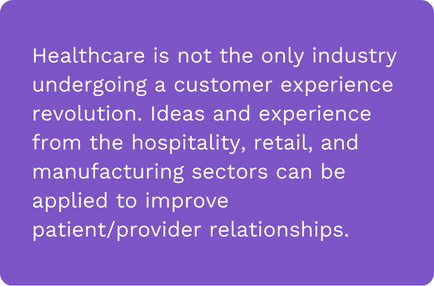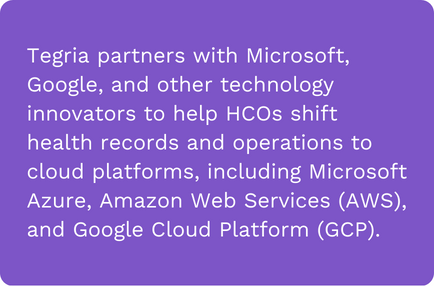Insight
Four Types of Patient Access Infrastructure
Which Patient Access Infrastructure Model is Right for You?
The four types of infrastructure care organizations need now to keep patients, providers, and staff happy
Toward a new vision of patient access
When seeking healthcare today, you expect convenience, multiple ways to connect with providers, and immediate and thoughtful care. You talk to an actual person when and how you want: in-person, or via secure message, or telehealth. You get proactive, helpful reminders that let you monitor your own care. You know in advance what you’ll pay and are rewarded for taking care of yourself. And your health information is controlled by you. On the provider side, modern patient access means having tools for direct scheduling, productive appointments, and seamless referrals. Schedules are filled, things run on time, and physicians know what’s going on with their patients. Intuitive dashboards help ensure that everyone has visibility into productivity, access, and quality metrics. Each patient’s journey is coordinated across the entire health system, and providers receive the right information at the right time—so care is precise and individualized. Records are accessed and follow-up care coordinated via portals instead of fax machines.
Be the provider of choice with frictionless engagement
The healthcare organizations (HCOs) winning the hearts and minds of today’s consumers successfully transition from analog to digital by seeking out patient feedback and understanding the perspectives of providers, care teams, administrators, and payers. They are investing in infrastructure to embed innovation, changing some aspects of provider culture, and adopting human-centric technology that improves experiences and outcomes. Read on for four ways providers are modernizing and simplifying so that patients, employees, and clinicians all have better experiences—and organizations perform at their best.
First-touch infrastructure
Self-scheduling and provider search via a user-friendly patient portal, natural language processing, symptom assessment bots, and customer relationship management (CRM) tools to track and enhance interactions
Without Tegria
In legacy healthcare systems…
- Finding the right care is hard.
- Scheduling an appointment is a time-consuming hassle.
- Appointments may not be available for weeks or months.
- Visits often don’t meet patient needs.
- Providers are rushed and frustrated and feel a loss of control.

With Tegria
What’s possible
It takes both smarter processes and infrastructure to get patients smoothly in the door. Give patients self-service options for scheduling and cancellation. Use instant messaging for confirmations and other communications. Enable voice and language recognition to help patients navigate their way. Speed up referral processing and records intake with automation and cloud storage. Offer optimized, well-designed coordination-of care components within EHRs. Give clinicians the support they need to properly triage patients and order appropriate labs and ancillary tests. Healthcare is not the only industry undergoing a customer experience revolution. Ideas and experience from the hospitality, retail, and manufacturing sectors can be applied to improve patient/provider relationships. These and other operational changes are a lot to manage. To realize actual value from new tech tools, start with experienced process designers who know how to marry optimal workflows with the right technology for your existing stack. It also takes an accompanying shift in culture and operations. You then will have the information and tools you need to customize care and build a patient relationship rooted in a foundation of community, inclusion, and trust.
Almost 70% of participants in a public opinion poll agree that the number one thing that could make them switch to another healthcare provider is the availability of same-day appointments for nonroutine issues.
— The Harris PollJanuary 2022
Patient and staff retention infrastructure
Advanced telephony and telecom systems, secure patient portals, workforce management and training platforms, CRM and data analytics tools, electronic health record (EHR) modules, process engineers and developers
Without Tegria
In legacy healthcare systems…
- Patients switch providers when faced with impersonal or hard-to-access care.
- Patient frustration leads to staff frustration.
- Talented staff head for the exits when systems are disjointed and disorganized.
- Inconsistent and incoherent leadership can snowball discontent.

With Tegria
What’s possible
With greater transparency, openness, and actionable data, staff can understand patient demands and align services accordingly. They can start to visualize the connections between community health needs and patterns of behavior in the patient population. They can use predictive analytics to manage supply (provider time, facility capacity) and demand. And patients can have better visibility into overall cost, clinical outcomes, and level of provider satisfaction. This takes the right people, training, support, and tech. Patient self-service tools such as a smooth-running telephony system or patient portal might require telecom and EHR module building expertise, as well as software development and process engineering talent. Making systems interoperable requires engineers with that experience. Needs around development, change management, governance, and accountability may crop up. So have a plan for workforce training and outside support. Tegria partners with Microsoft, Google, and other technology innovators to help HCOs shift health records and operations to cloud platforms, including Microsoft Azure, Amazon Web Services (AWS), and Google Cloud Platform (GCP). Better retention among patients and staff also requires a healthy company culture. Kindness and inclusivity lead to trust and loyalty from the community you serve. Essentials include continuing education, recognition and promotion of great staff, and support for team members to succeed and grow their own careers.
In a 2022 Harris Poll, 81% said that online scheduling options and other modern customer service technology would make a different provider more appealing.
Patient outreach infrastructure
Analytics to identify outpatients requiring intervention or follow-up, two-way texting, user-friendly designs that lead patients to the correct providers
Without Tegria
In legacy healthcare systems…
- The burden falls on patients to remember all they need to do.
- Finding the right provider is difficult.
- Information may not come in the ways patients want it delivered.
- Clinical integration is lacking, and at-risk patients may not be triaged appropriately.
- Technology gets layered on, not better, causing extra work for providers and sometimes burnout.
With Tegria
What’s possible
Proactive outreach and engagement are often enabled by patient access centers and optimized patient portals. These connect with patients in the ways they say they prefer—via phone, bidirectional texting, email, and more. Workflows for scheduling, patient intake, and health maintenance for high-risk patients are transformed, strengthening patient/provider relationships. Referral systems link diagnoses to appropriate provider groups to make sure patients see the correct treatment team. On the provider side, sophisticated analysis of demand/intake processes helps determine what visit distribution should look like (between in-person and virtual, for example) so that clinical time is most efficient. Care teams are empowered to navigate patients through their care paths and invited to provide feedback to make online tools even better. Building such a world-class experience center is about more than hyper-personal care. You gain patient experience feedback and market insights that help you understand your current environment and identify opportunities for improvement. You discover specialty care needs in your community, add telehealth or asynchronous consults to meet it, and bring care to those who have lacked access, addressing health equity.
Before we began implementing our patient access center, we had 40 different phone rooms across our distributed clinics. The patient experience was at times inconsistent and volatile. We wanted to provide a more standardized, scalable, and consistent patient experience. Tegria is helping us with identifying obstacles in our workflow that don’t align with best practices.
— MICHAEL CONDRINChief Operating Officer, Ambulatory Care, UC Davis
Infrastructure for resilience and disruption
AI to Live Voice, self and nurse triage, secure mobile applications, robotic process automation (for authorizations, refill requests, check-in, health status updates, payments, satisfaction surveys, and more)
Without Tegria
In legacy healthcare systems…
- Providers lose patients because competitors can schedule and see patients more quickly and with fewer prerequisites (such as medical review of a referral).
- Companies switch providers and take their employees with them.
- Great clinicians get discouraged by bad online reviews about scheduling hassles and wait times.
With Tegria
What’s possible
Healthcare experiences feel responsive and convenient when they strike the right balance of human contact and technology. Self-service tools are built around human-centered design principles. People can get done what they need to easily, from navigating with the help of an agent (for concierge services) to completing new patient intake to coordinating complex specialty care. Patients have reasonable access to communication with clinical teams. It’s such well-designed workflows and deft application of technology that lead to alignment of clinical requirements, patient safety, access, and supply and demand. They allow you to compete against new entrants to market, close the gap on your competition in terms of convenience, and limit your exposure to new participants such as Amazon. Patient needs can be integrated with clinical expertise into a positive feedback loop. And your staff will grow in digital skills, becoming an asset that you can grow and invest in—helping you cement your competitive edge.
Healthcare IT from people who know both
Becoming a nimble, consumer-focused healthcare organization takes know-how, processes, and tech integration
Tegria has worked with leading academic and research organizations to embed digital capabilities in every operational, administrative, and business development function. We’ve helped UCLA Health, UC Davis Health, Children’s Healthcare of Atlanta, Orlando Health, and Children’s Hospital Colorado across all aspects of innovative care. For us, innovation is about compassion as well as bold breakthroughs in care, technology, revenue, and operations. It’s about making healthcare experiences more personal, warm, and welcoming for each patient. Drawing on our deep roots in healthcare, we work with each client to identify their unique needs and build integrated solutions to their greatest challenges. We deliver high-quality, reliable data and insights, simplify processes, improve workload efficiency, and boost financial results. This is how organizations can create better patient experiences, attract, and retain great talent, and make healthcare delivery feel more human.
Patient Access Excellence: Leon Medical Centers
Leon Medical Centers in Miami-Dade County, Florida cares for 42,000-plus Medicare patients. On average, each “member” sees their physician five to seven times a year with the emphasis on preventive medicine. Free transportation is provided to seven medical centers served by more than 2,300 physicians. Leon offers onsite pharmacies, laboratories, dental and eye care, CT scans, and MRIs. A 24/7 call center is open for anything from scheduling appointments to connecting with a doctor. With My Leon, members have full, secure access to their EHRs, which also go with them if they travel out of state. Leon’s service philosophy, “Personal Attention at All Times,” permeates the entire healthcare system.